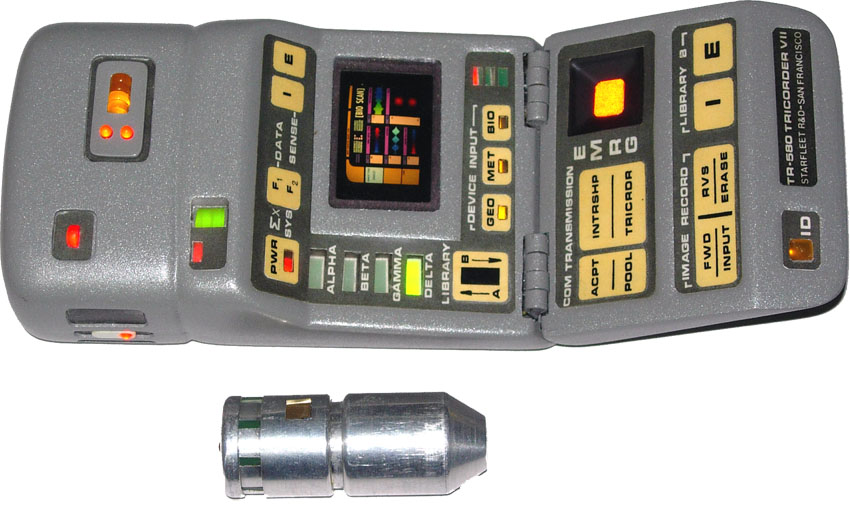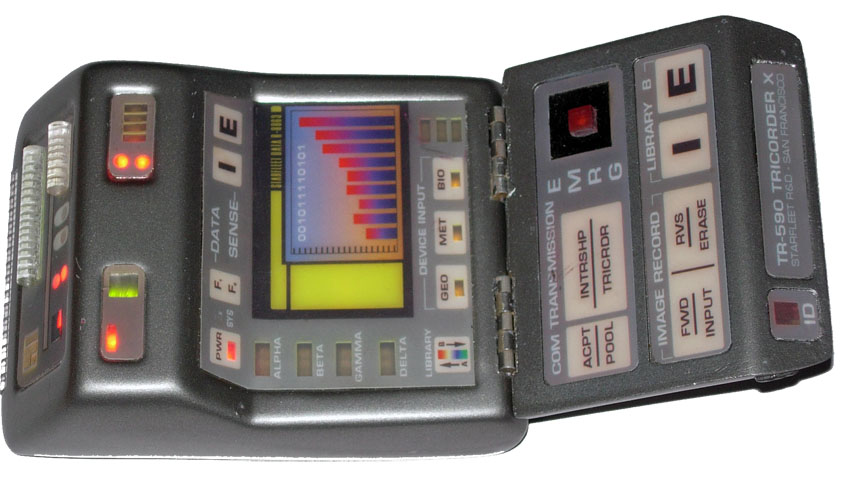You are using an out of date browser. It may not display this or other websites correctly.
You should upgrade or use an alternative browser.
You should upgrade or use an alternative browser.
TNG Tricorder Evolution Thread
- Thread starter stapleton13
- Start date
Blinkieman
New Member
Really cool to have some of the original makers on here. How were the electronics done? Prototyped and etched custom circuit boards, or more of a kitbashed sort of thing?
Always been very impressive, either way.
The electronics were done various ways. If it was a one time deal or was needed ASAP it was thrown together. If we knew their would be more than a few we would create "better" PCBs.
For example the "First Contact" medical tricorder. I had a short time to design and build the electronics. I really wanted to incorporate blue LEDs into a tricorder. Back then when this was built blue LEDs were costly and not plentiful. SMT LEDs were not an option. I had to machine all the blue's by hand to make them fit! I used some of my stock driver boards to quickly get it up and running. These driver boards are smaller than a postage stamp and they were typically used for cortical stimulators, scanners or anything that needs flashing lights. I hand wired these little boards together to get it out the door.
The Voyager Relativity tricorder (24th century) and the Endgame tricorders were built using these same methods.
The Mark 9 and 10 tricorders had a lot more time to design and build so they had custom etched PCBs.
Brian
The electronics were done various ways. If it was a one time deal or was needed ASAP it was thrown together. If we knew their would be more than a few we would create "better" PCBs.
For example the "First Contact" medical tricorder. I had a short time to design and build the electronics. I really wanted to incorporate blue LEDs into a tricorder. Back then when this was built blue LEDs were costly and not plentiful. SMT LEDs were not an option. I had to machine all the blue's by hand to make them fit! I used some of my stock driver boards to quickly get it up and running. These driver boards are smaller than a postage stamp and they were typically used for cortical stimulators, scanners or anything that needs flashing lights. I hand wired these little boards together to get it out the door.
The Voyager Relativity tricorder (24th century) and the Endgame tricorders were built using these same methods.
The Mark 9 and 10 tricorders had a lot more time to design and build so they had custom etched PCBs.
Brian
Very cool to have you here brian! The small driver boards sound very cool, do you have specs or model numbers, they sound very useful when making small pieces!
Blinkieman
New Member
Very cool to have you here brian! The small driver boards sound very cool, do you have specs or model numbers, they sound very useful when making small pieces!
They are called Odo boards. I made tons of them. Someone on set once said "on DS9 those boards are everywhere and I wouldn't be surprised if next week Odo has one plastered to his forehead". The name stuck and I even etched Odo on the driver boards.
They can be cut down to fit into the smallest props. The Mark X medical hand scanner used them to sequence the LEDs.
Brian
MGC
Sr Member
They are called Odo boards. I made tons of them. Someone on set once said "on DS9 those boards are everywhere and I wouldn't be surprised if next week Odo has one plastered to his forehead". The name stuck and I even etched Odo on the driver boards.
They can be cut down to fit into the smallest props. The Mark X medical hand scanner used them to sequence the LEDs.
Brian
Now THAT is the kind of info you don't get anywhere else. Thanks man!
Dave Porter
Sr Member
I agree!!
More info on these boards please (just getting into electronics for fun, and the small blinky light props are what I want to do)
More info on these boards please (just getting into electronics for fun, and the small blinky light props are what I want to do)
trekprops.de
Well-Known Member
Great story on the name. I love it! 
thegreatgalling
Master Member
Thanks Brian! Great story! More more!
Awesome pics Boomer, I love the Voyager Mark VII screen.
Awesome pics Boomer, I love the Voyager Mark VII screen.
Blinkieman
New Member
I agree!!
More info on these boards please (just getting into electronics for fun, and the small blinky light props are what I want to do)
The boards are able to sequence 5 LEDs. The speed is adjustable. There is an option to pseudo random flash the LEDs.
The Endgame tricorder design was actually influenced by the boards! If you notice the alpha, beta, gamma and delta LED area has 5 on the Endgame! That is because when I designed the graphics I knew I would be in a time crunch and would be using the Odo boards. The Odo boards are able to drive 5 LEDs so I added the 5th to the graphics.
Also note a little inside joke on the Endgame graphics. Rick Sternbach designed the tricorder. He handed the drawing to us. I designed the graphics and wanted to make this one more "high tech" than the previous models. Rick drew only one label on the production drawing... OSX! An homage to the old 21st century OS. Rick was leaving Trek after this episode. I kept the label as an homage to Rick. Years later I had lunch with Rick. He mentioned that leaving Trek was very emotional. He said I do remember having one last smile...the OSX label!
Brian
thegreatgalling
Master Member
Great story! Thanks for sharing!
Thats a awesome story, love the OSX part! Sooo....still making these boards *Hint Hint*
YenChih Lin
Master Member
How and which hinges made ratcheting sound on the Mark VI/VII? Or was that all post-pro?
YenChih Lin
Master Member
Anay chance to see a pic of the spring load? And I thought the ratcheting sound was actually THAT loud...
propalooza
Active Member
I'm making graphics for a Mark VII can anyone I.D. the font used?
Similar threads
- Replies
- 4
- Views
- 265
- Replies
- 3
- Views
- 1,516
- Replies
- 14
- Views
- 2,810




